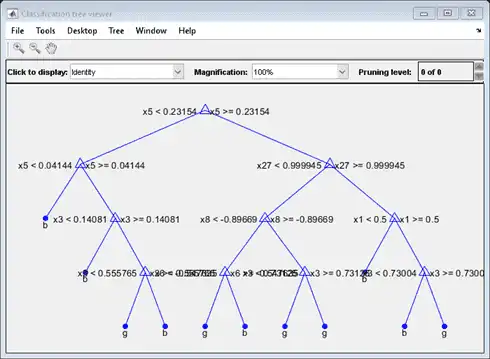Ensemble classifier
Description
ClassificationEnsemble combines a set of trained weak learner models and data on which these learners were trained. It can predict ensemble response for new data by aggregating predictions from its weak learners. It stores data used for training, can compute resubstitution predictions, and can resume training if desired.
Construction
Create a classification ensemble object using fitcensemble.
Properties
|
CategoricalPredictors Categorical predictor indices, specified as a vector of positive integers. |
|
ClassNames List of the elements in |
|
CombineWeights Character vector describing how ens combines weak learner weights, either 'WeightedSum' or 'WeightedAverage'. |
|
Cost Square matrix, where Cost(i,j) is the cost of classifying a point into class j if its true class is i (the rows correspond to the true class and the columns correspond to the predicted class). The order of the rows and columns of |
|
ExpandedPredictorNames Expanded predictor names, stored as a cell array of character vectors. If the model uses encoding for categorical variables, then ExpandedPredictorNames includes the names that describe the expanded variables. Otherwise, ExpandedPredictorNames is the same as PredictorNames. |
|
FitInfo Numeric array of fit information. The FitInfoDescription property describes the content of this array. |
|
FitInfoDescription Character vector describing the meaning of the FitInfo array. |
|
HyperparameterOptimizationResults Description of the cross-validation optimization of hyperparameters, stored as a BayesianOptimization object or a table of hyperparameters and associated values. Nonempty when the
|
|
LearnerNames Cell array of character vectors with names of weak learners in the ensemble. The name of each learner appears just once. For example, if you have an ensemble of 100 trees, LearnerNames is {'Tree'}. |
|
Method Character vector describing the method that creates ens. |
|
ModelParameters Parameters used in training ens. |
|
NumObservations Numeric scalar containing the number of observations in the training data. |
|
NumTrained Number of trained weak learners in ens, a scalar. |
|
PredictorNames Cell array of names for the predictor variables, in the order in which they appear in X. |
|
Prior Numeric vector of prior probabilities for each class. The order of the elements of Prior corresponds to the order of the classes in ClassNames. The number of elements of Prior is the number of unique classes in the response. This property is read-only. |
|
ReasonForTermination Character vector describing the reason fitcensemble stopped adding weak learners to the ensemble. |
|
ResponseName Character vector with the name of the response variable Y. |
|
ScoreTransform Function handle for transforming scores, or character vector representing a built-in transformation function. Add or change a ens.ScoreTransform = 'function'
or ens.ScoreTransform = @function
|
|
Trained A cell vector of trained classification models.
|
|
TrainedWeights Numeric vector of trained weights for the weak learners in |
|
UsePredForLearner Logical matrix of size If the ensemble is not of type |
|
W Scaled |
|
X Matrix or table of predictor values that trained the ensemble. Each column of |
|
Y Numeric vector, categorical vector, logical vector, character array, or cell array of character vectors. Each row of |
Object Functions
compact |
Compact classification ensemble |
compareHoldout |
Compare accuracies of two classification models using new data |
crossval |
Cross-validate ensemble |
edge |
Classification edge |
gather |
Gather properties of Statistics and Machine Learning Toolbox object from GPU |
lime |
Local interpretable model-agnostic explanations (LIME) |
loss |
Classification error |
margin |
Classification margins |
partialDependence |
Compute partial dependence |
plotPartialDependence |
Create partial dependence plot (PDP) and individual conditional expectation (ICE) plots |
predict |
Classify observations using ensemble of classification models |
predictorImportance |
Estimates of predictor importance for classification ensemble of decision trees |
resubEdge |
Classification edge by resubstitution |
resubLoss |
Classification error by resubstitution |
resubMargin |
Classification margins by resubstitution |
resubPredict |
Classify observations in ensemble of classification models |
resume |
Resume training ensemble |
shapley |
Shapley values |
testckfold |
Compare accuracies of two classification models by repeated cross-validation |
Copy Semantics
Value. To learn how value classes affect copy operations.
Examples
Train Boosted Classification Ensemble
Load the ionosphere data set.
load ionosphere
Train a boosted ensemble of 100 classification trees using all measurements and the AdaBoostM1 method.
Mdl = fitcensemble(X,Y,'Method','AdaBoostM1')
Mdl =
ClassificationEnsemble
ResponseName: 'Y'
CategoricalPredictors: []
ClassNames: {'b' 'g'}
ScoreTransform: 'none'
NumObservations: 351
NumTrained: 100
Method: 'AdaBoostM1'
LearnerNames: {'Tree'}
ReasonForTermination: 'Terminated normally after completing the requested number of training cycles.'
FitInfo: [100x1 double]
FitInfoDescription: {2x1 cell}
Properties, Methods
Mdl is a ClassificationEnsemble model object.
Mdl.Trained is the property that stores a 100-by-1 cell vector of the trained classification trees (CompactClassificationTree model objects) that compose the ensemble.
Plot a graph of the first trained classification tree.
view(Mdl.Trained{1},'Mode','graph')

Tips
For an ensemble of classification trees, the Trained property of ens stores an ens.NumTrained-by-1 cell vector of compact classification models. For a textual or graphical display of tree t in the cell vector, enter:
-
view(ens.Trained{for ensembles aggregated using LogitBoost or GentleBoost.t}.CompactRegressionLearner) -
view(ens.Trained{for all other aggregation methods.t})